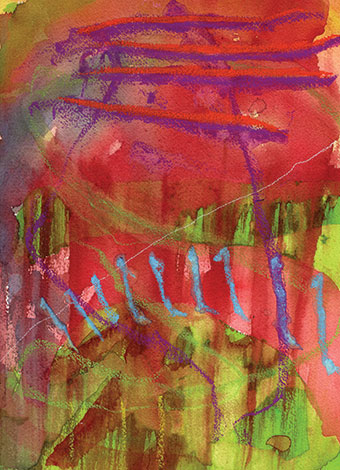Next story: Nate Peracciny's photographs at Allen Street Hardware
Nathan Naetzker's paintings at Weeks Gallery
by J. Tim Raymond

Beyond Influence
Nathan Naetzker’s paintings at Jamestown Community College’s Weeks Gallery
I recently spent an afternoon with painter Nathan Naetzker. On an earlier evening, over good Scotch, we had talked of life and its occasional weighted significance, but this afternoon I was in his studio overlooking a patented Burchfield winter landscape to talk about his work.
Naetzker is a teacher and painter, a particularly bittersweet amalgam: He feels fortunate to be employed but must also make time to work on his art. Living in ArtSpace, one of Buffalo’s burgeoning cultural venues, Naetzker has managed to keep a balance, teaching full time and exhibiting his paintings regularly. We found considerable mutual interests in artists over the centuries, especially in the landscape and figurative works of the Dutch Master Vermeer and the cloud studies of 19th-century English painter John Constable.
Many of us at ArtSpace have inherited furniture from our families to grace the considerable expanses of our apartments. In my case, it’s a small Chinese lamp left to me from my grandparents. In Nathan’s, a bright red leather upholstered armchair with brass tacks. It was the chair he retreated behind as a child absorbed in the coffee-table version of Andrew Wyeth’s book of landscapes. Growing up in the Western New York stretches of Appalachia around 1970s Jamestown, he found a special inspiration in the paintings of Vermeer, where the form of the work and the life that inspired it comprised a total expression. The often barren surroundings of the foothills of the eastern Allegany found a counterpart in the paintings of Wyeth’s Pennsylvania outback. His egg-tempera depictions of wind wallows and sere outbuildings in the biting cold of the Brandywine countryside, along with his studies of the bright raw beauty of the Maine coastline, had over time mutated into “barn art,” the picturesque landscape staple of art fairs everywhere, usually with a rusted cowbell or pig trough to give a nostalgic sniff to a fabled agrarian past.
Light in a landscape can build a mental space as sharp as architecture. The way the passage of light falls in a painting offers the viewer a space to witness the artist’s investment in the visual weight of a place; where the facture of light and shadow construct a fine balance between the weighted form the paint takes and the painted space of “air.” The sense of painted light on painted landmass can create an identity of place in the mind of the viewer in just two strokes of pigment. In Naetzker’s images, there is the added weight of cold judgment and guilt, and both a hidden and searching quality in his vantage point that pushes past ordinary scenes of nudes and denuded landscapes into something metaphysical. The patient reserve of his painted narrative subjects contrasts with his evident impatience for the next painting breaking on the headlands of his imagination.
In his recent work, Naetzker’s deft handling of paint representationally has taken a spirited leap into lush compositions of abstract gestural brushwork, in passages of exuberant pigment in dappled, free-floating, improvisational variations of Kandinsky-like watercolors.
Naetzker says he’s at a turning point in his artistic life, moving from a strong academic rubric of revered artists, internalizing their influences while focusing his own vision, autobiographical, metaphorical in the best sense, and always moving away from category, from cant, from unexamined corporate civility.
His work is currently featured in an exhibition at Jamestown Community College’s Weeks Gallery entitled Fact, Fiction and Fantasy.
—j. tim raymond
blog comments powered by Disqus|
Issue Navigation> Issue Index > v10n7 (Week of Thursday, February 17) > Art Scene > Nathan Naetzker's paintings at Weeks Gallery This Week's Issue • Artvoice Daily • Artvoice TV • Events Calendar • Classifieds |









 Current Issue
Current Issue